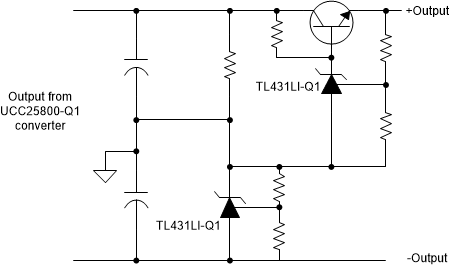SLUAAB9A March 2021 – December 2021 UCC25800-Q1
- Trademarks
- 1 Introduction
- 2 Open-Loop LLC Converter Operation Principle
- 3 Primary-side and Secondary-side Resonant Configurations
- 4 Rectification Methods
- 5 LLC Transformer Design Steps
- 6 Negative Voltage Generation
- 7 Multiple-output Design
- 8 EMI Performance
- 9 Common-Mode Transient Immunity (CMTI)
- 10Summary
- 11Revision History
6.3 Using a Shunt Regulator and Linear Regulator
In some cases, both the positive output and negative output need to be well regulated. In this case, an extra linear regulator can be used to improve the positive voltage rail voltage accuracy. The circuit diagram is shown in Figure 6-3. The linear regulator is added on top of the shunt regulator circuit. In this case, both the positive output and negative output are well regulated. When designing the LLC converter output voltage, the extra voltage drop on the linear regulator must be considered.
 Figure 6-3 Shunt Regulator And Linear
Regulator To Split The Output Voltage
Figure 6-3 Shunt Regulator And Linear
Regulator To Split The Output Voltage